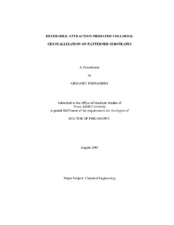| dc.contributor.advisor | Bevan, Michael A. | |
| dc.creator | Fernandes, Gregory | |
| dc.date.accessioned | 2010-01-15T00:09:18Z | |
| dc.date.accessioned | 2010-01-16T01:04:31Z | |
| dc.date.available | 2010-01-15T00:09:18Z | |
| dc.date.available | 2010-01-16T01:04:31Z | |
| dc.date.created | 2008-08 | |
| dc.date.issued | 2009-05-15 | |
| dc.identifier.uri | https://hdl.handle.net/1969.1/ETD-TAMU-2900 | |
| dc.description.abstract | In this dissertation we used tunable particle-particle and particle-substrate
attraction to achieve reversible two-dimensional crystallization of colloids on
homogeneous and patterned substrates. Total internal reflection and video microscopy
techniques were used to quantify the interparticle and particle-substrate interactions in
these colloidal systems. Equilibrium and dynamic simulations were then utilized to link
these colloidal interactions to the experimental colloidal phase behaviour. The
importance of the nature of the attractive interaction in successfully crystallizing colloids
has also been documented.
The first set of experiments demonstrates the use of temperature and specific ion
effects to reversibly control the net particle-substrate van der Waals (vdW) attraction.
Colloidal stabilization was achieved via the use of adsorbed polymer brush layers. By
using evanescent wave microscopy, we directly and precisely measured how temperature
and specific ion effects control the dimensions of adsorbed polymer layers and hence the
net van der Waals attraction in between the colloids and the substrate. However, the magnitude of the van der Waals attraction decays very rapidly with increasing surface
separation and is therefore not conducive to the self assembly of colloidal crystals.
We successfully used thermoresponsive polymer nanoparticles to control the
depletion attraction between micron sized silica particles and thereby induced reversible
crystallization of the micron sized silica colloids on homogeneous substrates. Video and
evanescent wave microscopy techniques were used to measure the nanoparticle-induced
attractive interaction as a function of temperature. The experimentally observed phase
behaviour was verified via simulations that utilized knowledge of the measured colloidal
depletion interactions.
Finally, patterned surface topologies were used to position attractive colloidal
crystals. Simulations were used to link the measured colloidal interactions to
experimental phase behaviour as well as substrate topology. An extension of the
concepts developed in this dissertation might suggest a general strategy to assemble
colloidal particles into robust and annealable crystals contributing to the fabrication of
photonic bandgap materials. | en |
| dc.format.medium | electronic | en |
| dc.format.mimetype | application/pdf | |
| dc.language.iso | en_US | |
| dc.subject | Colloids | en |
| dc.subject | Depletion | en |
| dc.subject | Patterns | en |
| dc.subject | Crystallization | en |
| dc.subject | Two-Dimensional | en |
| dc.subject | Attraction | en |
| dc.title | Reversible Attraction-Mediated Colloidal Crystallization on Patterned Substrates | en |
| dc.type | Book | en |
| dc.type | Thesis | en |
| thesis.degree.department | Chemical Engineering | en |
| thesis.degree.discipline | Chemical Engineering | en |
| thesis.degree.grantor | Texas A&M University | en |
| thesis.degree.name | Doctor of Philosophy | en |
| thesis.degree.level | Doctoral | en |
| dc.contributor.committeeMember | Cheng, Zhengdong | |
| dc.contributor.committeeMember | Cremer, Paul S. | |
| dc.contributor.committeeMember | Silas, James | |
| dc.type.genre | Electronic Dissertation | en |
| dc.type.material | text | en |
| dc.format.digitalOrigin | born digital | en |


